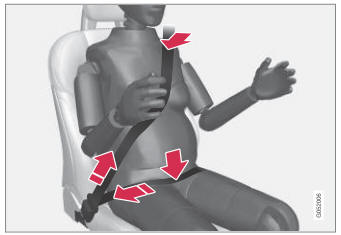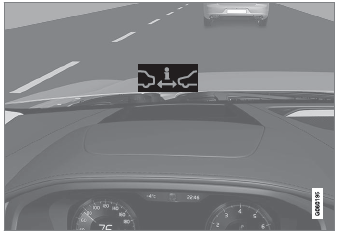Volvo XC90: Safety / Safety during pregnancy
It is important that seat belts are worn correctly during pregnancy and that pregnant drivers adjust their seating position accordingly.
Seat belt

The seat belt should fit closely against the shoulder, with the diagonal section between the breasts and to the side of the stomach.
The lap section of the seat belt should lie flat over the thighs and as far as possible under the stomach. Never let it ride upward. Remove unnecessary slack and make sure the seat belt fits as close as possible to the body. Make sure there are no twists in the seat belt.
Seating position
As pregnancy progresses, pregnant drivers should adjust the seat and steering wheel to a position that allows them to retain full control of the vehicle (which means they should be able to easily reach the steering wheel and foot pedals). Try to maintain as much distance as possible between the stomach and the steering wheel.
 Safety
Safety
Safety
The vehicle is equipped with a number of safety systems that work together to help protect the vehicle's driver and passengers in the event of an accident...
 Occupant safety
Occupant safety
Safety is Volvo's cornerstone.
Volvo's concern for safety
Our concern for safety dates back to 1927 when the first Volvo rolled off the
production line...
Other information:
Volvo XC90 2015-2025 Owners Manual: The Launch function
(Option/accessory.) Launch can be used to provide maximum acceleration from a standstill. The function is available for the drive modes: Dynamic, Comfort and Individual. Activating Launch Make sure that the vehicle is stationary and that the wheels are pointing straight ahead...
Volvo XC90 2015-2025 Owners Manual: Park Assist Pilot limitations
(Option/accessory. Park Assist Pilot (PAP1) may not be able to detect all conditions in all situations and functionality may therefore be limited. The driver should be aware of the following limitations for Park Assist Pilot. WARNING The parking sensors have dead/blind spots where objects cannot be detected...

